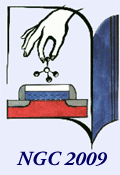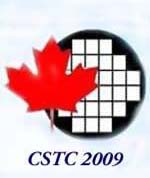
|
Nano and Giga Challenges in Electronics, Photonics and Renewable Energy | 14th Canadian Semiconductor Technology Conference |

 |
|
 |
|
|
Commentary
There are two large groups of solid-state radiation detectors, which dominate the area of ionizing radiation measurements, scintillation detectors and semiconductor diodes. Semiconductor diodes employ reverse biased p-n junctions where the absorbed radiation creates electrons and holes, which are separated by the junction field thereby producing a direct electrical response. Scintillators detect high-energy radiation through generation of light which is subsequently registered by a photo-detector that converts light into an electrical signal. An essential advantage of the semiconductor scintillator is that each scintillator slab can be supplied with its own photo-detector. Such slabs can then be stacked up without limit, thus enabling the possibility of three-dimensional (3D) pixellation of Compton scatterings of the incident gamma photon. The 3D pixellation in turn enables rapid simultaneous determination of both the incident gamma-photon energy and the direction to its source. These two tasks - isotope discrimination and directional resolution - are the two most important challenges in the apprehension of evil-doers carrying radioactive materials. Thus, semiconductor scintillators are highly desirable. However, scintillators are not normally made of semiconductor material. The key issue in implementing a semiconductor scintillator is how to make the semiconductor essentially transparent to its own infrared light, so that photons generated deep inside the semiconductor slab could reach its surface without tangible attenuation. I will discuss several ways how this can be accomplished, all subject of intense research. One way is based on heavy doping of bulk semiconductor with shallow donors, so as to introduce the Moss-Burstein shift between the emission and the absorption spectra. In semiconductors with degenerate carrier concentrations, the edge of absorption is blue-shifted relative to the emission edge. This approach is actively pursued in our laboratory at Stony Brook with InP used as the scintillator material. It turns out that heavy doping does improve the transparency of a semiconductor slab against interband absorption but it also increases the free-carrier absorption (FCA) in the doped material. Because of the high radiative efficiency of InP, minority carriers and photons exist in the n-type material as "interchangeable entities" (the effect is called the photon recycling). Every instance of interband absorption creates a new hole, which recombines producing another photon in a random direction. While the entity is a photon, its lifetime is limited by FCA and while it is a hole, the lifetime is limited by non-radiative processes, such as Auger recombination. Both limitations arise because of the heavy doping, needed to effect the Burstein shift. Another way under investigation is to use lightly doped p-type semiconductors and rely on impurity-related radiative recombination, which is red-shifted relative to the fundamental absorption edge. Again, recombination of the minority carriers (now electrons) generates an internal emission spectrum comprising both "transparent" long wavelength photons (those which reach the slab surface) and short wavelength photons, which are re-absorbed producing another electron and subsequently another internal emission cycle. If the radiative recombination efficiency is high, as it is in direct-gap semiconductors, such as GaAs or InP, then one can expect nearly full collection of scintillating radiation by the photodiode integrated on the semiconductor surface. Still another - tantalizing but not yet realized in practice - possibility lies in employing composite "impregnated" materials. The "host" semiconductor body absorbs gamma-rays but itself neither generates nor absorbs scintillating radiation. That radiation is produced by multiple small direct-gap "guest" semiconductor inclusions of bandgap slightly narrower than that of the host material. If the typical distance between these impregnations is shorter than the diffusion length of carriers in the host material, most of the radiative recombination will occur inside the inclusions and produce scintillating radiation to which the wide-gap body is essentially transparent. In this way it is possible in principle to implement a scintillation material where the photon mean free path exceeds centimeter or even decimeter dimensions. The key challenges for this approach are in the crystal growth. One has to find an appropriate technique that would be capable of producing millimeter-thick impregnated structures. One possible direction is epitaxial growth of the host with periodic interruptions that introduce random guest inclusions that do not obstruct further epitaxial growth. This is reminiscent of quantum-dot laser structures, except that no quantum-size effect is sought and the requirements to uniformity are very relaxed. On the other hand, the desired thickness is much larger than that commonly used in epitaxial applications. Another possibility for introducing inclusions is to employ the natural tendency of some material systems to phase-separate via spinodal decomposition during the crystal growth. In this way one can envisage impregnated materials produced by bulk growth techniques. Needless to say, the implementation of impregnated scintillator structures is a challenging proposition. Nevertheless, it offers a very high pay-off, especially in homeland security applications, where the development of an efficient semiconductor scintillator offers unprecedented opportunities for isotope discrimination and directional resolution. In my opinion, the search for the right material combination and sound fabrication technology merits a concerted effort in several directions. |